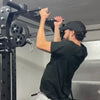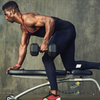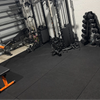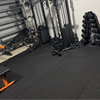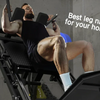How to Build a Home Gym
Building a home gym can be an exciting journey that leads to improved fitness. Whether you're aiming to build strength, lose weight, or improve overall health, creating the best home gym setup with the right home gym equipment will give you a space for consistent, effective workouts. This guide will walk you through the essentials of setting up your home gym, from choosing the best gym equipment for home use to setting up your workout space.
In this ultimate guide, we'll walk you through the essential steps and the best equipment for a home gym tailored to your needs. Let's dive in!

The Case For Home Gyms
Having a home gym unlocks a level of convenience and flexibility that no commercial setup can match. Here are some of the standout benefits of building a home gym:
- Work Out on Your Own Schedule: A home gymnasium is open 24/7—no sign-ups, no time limits, and no waiting for equipment. Whether you're an early riser or prefer late-night sweat sessions, your gym is always ready when you are.
- Train How You Want: Working out in your own space means you're in total control. You choose the home gym equipment and the home gym setup. Want a home gym full of free weights? Done. Prefer a setup focused on cardio? No problem. It's your gym, you rules. Plus, RitKeep offers budget-friendly, high-quality options, making creating a setup that's perfect for your unique needs easier.
- No Crowds, No Waiting: Let's face it—gym traffic can be a major hassle. Building a home gym means you can train at your own pace, in your own space, without the distractions and frustrations of a commercial gym environment.
- Long-Term Savings: While building a home gym requires an upfront investment, the long-term savings can be significant. Over time, your home gym will pay for itself, and with durable gear from RitKeep, you won't have to worry about constant replacements.
Home Gym Essentials: Crafting the Perfect Workout Space for Every Need
Setting up a home gym with the right home gym equipment requires careful planning to ensure it meets your fitness needs and fits seamlessly into your lifestyle. Here are some essential tips and tricks to help you choose the perfect home gym equipment and layout for a versatile workout space at home:
Assess Your Space
Before buying any home gym equipment, take the time to measure your available space. Ensure there's enough room for your home gym equipment and for you to move freely and safely during workouts. Consider the height of the ceiling if you plan on using equipment like pull-up bars or suspension trainers. Assessing your space upfront will prevent overcrowding and ensure a comfortable workout environment.
Prioritize Your Fitness Goals
Your home gym should be tailored to your specific fitness goals. Whether you aim to build strength, improve cardiovascular health, enhance flexibility, or all of the above, your equipment choices should reflect these objectives. For strength training, prioritize weights such as dumbbells and barbells. If cardio is your focus, invest in equipment like a treadmill. Understanding your goals will guide you in selecting the right equipment that supports your fitness journey.
Budget Wisely
You don't need to break the bank to create an effective home gym. Start with the home gym essentials that align with your immediate fitness goals and budget constraints. Begin with versatile equipment like adjustable dumbbells, resistance bands, or a yoga mat. These items offer a wide range of exercise options without requiring significant upfront costs. Alternatively, we offer train now, pay later options.
Stay Motivated
Maintaining motivation is key to consistency in your fitness routine. Create an inspiring environment in your home gym that encourages you to stay committed. Consider decorating your workout space with motivational posters or quotes that resonate with your fitness goals. Ensure adequate lighting to create a bright and inviting atmosphere. Adding a sound system can also enhance your workout experience by playing energizing music or workout playlists that keep you motivated during exercise sessions. Small touches like these can significantly impact your mindset and keep you motivated to achieve your fitness goals.
Building a Home Gym by Fitness Goals
When creating a home gym, your home gym setup should reflect your primary fitness goals. Whether you're aiming to shed fat, pack on muscle, or develop overall strength, the home gym workout equipment you choose will directly impact the effectiveness of your training. Here's a breakdown of some key approaches based on different goals:
For Strength Training: Building Muscle and Power
Building muscle and strength is at the core of many fitness goals. To effectively target various muscle groups, you need good home workout equipment that supports a range of exercises with proper form and safety.
Smith Machine
For strength training, a Smith machine squat is a great option for beginners and anyone looking to lift heavy without a spotter. This essential home gym equipment provides stability and control while allowing you to isolate muscles and perform exercises like bench presses, squats, and overhead presses.
- Pros: Provides additional stability and safety during exercises, making it perfect for beginners or those who prefer machine-based exercises.
- Pros: Great for isolating muscle groups and performing exercises like bench presses, squats, and overhead presses.
- Pros: Minimizes the risk of injury, especially when training without a spotter.
Power Rack
A power rack is the centerpiece of any serious strength training setup. If you're serious about strength training, a power rack with a cable system is indispensable because it lets you safely perform compound movements, which are essential for building muscle and strength.
- Pros: Provides a safe environment for heavy lifts like squats, deadlifts, and bench presses.
- Pros: Allows for a wide variety of exercises, including pull-ups, chin-ups, overhead presses, and more.
- Pros: Adjustable features to suit various heights and body types.
- Pros: Can often be used with additional power rack attachments to further expand your workout options.
Barbell and Weight Plates
Barbells and weight sets are fundamental for strength training. The barbell bar can be used for compound lifts such as squats, deadlifts, bench presses, and overhead presses. Weight plates come in different increments to allow for gradual weight progression. The ability to load different amounts of weight makes them versatile and effective for achieving long-term progress.
- Pros: Essential for building strength and muscle mass through compound exercises.
- Pros: Allows for progressive overload, which is key for muscle growth and strength.
- Pros: Supports a wide variety of exercises targeting both upper and lower body.
Adjustable Dumbbells
Adjustable dumbbell sets are compact and space-saving alternatives to a full set of fixed-weight dumbbells. Their versatility makes them ideal for a wide range of exercises, from strength training to functional fitness. The ability to adjust weights makes them especially perfect for home gyms, where space is often limited.
- Pros: Space-saving and versatile—perfect for a home gym where space might be limited.
- Pros: Allows for a wide variety of exercises for both upper and lower body, including isolation exercises like bicep curls and chest flies.
-
Pros: Helps with progressive overload as you can easily adjust the weight to increase intensity.

Weight bench
The gym weight bench is an essential piece of equipment for pressing movements, such as bench presses, incline presses, and various dumbbell exercises. It's indispensable for performing effective chest and shoulder workouts, as well as dumbbell exercises.
- Pros: Provides a stable platform for pressing exercises like bench press and shoulder press.
- Pros: Can be adjusted to different angles to target different areas of the chest, shoulders, and triceps.
- Pros: Some benches also offer features like leg extensions for lower body exercises.
For Cardiovascular Fitness: Boosting Endurance and Fat Loss
Cardio exercises are vital for improving cardiovascular health, increasing endurance, and burning calories. These fitness equipments for home gym help you build stamina, lose fat, and improve heart health.
Battle Ropes
A battle rope is a thick, heavy rope used for a variety of full-body workouts. Battle ropes are one of the best tools for metabolic conditioning. They help burn calories quickly while also building strength, making them an excellent option for those focused on fat loss and endurance.
- Pros: Great for full-body conditioning, improving both strength and endurance.
- Pros: Engages your core, arms, shoulders, and legs with every wave.
- Pros: Can be used for a variety of dynamic movements (waves, slams, circles) to increase cardiovascular fitness.
For Flexibility and Recovery
Flexibility and mobility exercises help prevent injury, promote muscle recovery, and improve movement patterns. These tools are ideal for stretching, yoga, and rehabilitation.
Mat
High-quality floor mats are essential for any floor-based exercises, whether it's stretching, yoga, Pilates, or bodyweight exercises. It's a must-have for anyone who plans to incorporate flexibility and mobility work into their routine.
- Pros: Provides cushioning and stability for exercises performed on the floor.
- Pros: Prevents slipping and protects your joints during exercises like push-ups, sit-ups, or yoga poses.
- Pros: Easy to store and transport.
Resistance Bands
Resistance bands are compact, affordable tools that offer a wide range of uses—from strength training and stretching to mobility work and rehabilitation. Their versatility makes them ideal for both beginners and advanced users looking to improve performance, flexibility, or recovery.
- Pros: Great for warming up, stretching, and adding resistance to bodyweight exercises (e.g., squats, lunges, push-ups).
- Pros: Can also be used for rehabilitation exercises to strengthen joints and muscles.
- Pros: Portable and lightweight, making them perfect for home use or traveling.
Designing Your Home Gym Layout
Once you've chosen the home gym exercise equipment, it's time to think about the layout of your space. A well-organized gym will not only make it more enjoyable to work out, but it will also help keep you safe. Here's how to plan your layout:
- Flow and Accessibility: Arrange your home gym machine in a way that allows you to move freely between exercises. For example, place your cardio equipment in one area, strength training equipment in another, and stretching or yoga space in a quieter corner.
- Adequate Space Around Equipment: Make sure there's enough room to perform exercises safely. For example, you'll need space to use a squat rack, swing kettlebells, or move through a HIIT circuit.
- Storage: Invest in storage solutions such as shelves, racks, or bins to keep your home gym equipment organized. This is especially important for smaller items like dumbbells, resistance bands, and kettlebells.
- Mirrors: Home gym mirrors are not only great for checking your form, but they can also make the space look bigger and brighter. Consider installing full-length mirrors on one wall.
Ultimate Home Gym Guide: FAQs
What is a must for a home gym?
This is really going to depend on your goals, but I would suggest starting with a power rack, barbell, and a set of plates or a pair of adjustable dumbbells if you're short on space. You may also consider cardio equipment like a treadmill or a stationary bike.
I have a limited budget. How do I get the most bang for my buck?
RitKeep has products to outfit your home gym with almost any budget. Jumpstart your fitness journey at home with inexpensive equipment like a jump rope, plyo box, and dumbbells. Look for multi-functional products like a power rack with accessories for versatile workout options. A limited budget doesn't mean you have to have a limited workout. RitKeep has affordable equipment for people at all levels of fitness.
Is 10×10 big enough for a home gym?
It can be with a little ingenuity. A 10 x 10 is considered common for home gyms because it allows you to fit the essentials, but is still somewhat cramped at 100 square feet. Your ideal home gym footage should be around 150 to 250 square feet. If you're low on space, you might consider purchasing good home workout equipment that can easily be folded and stored when not in use.







